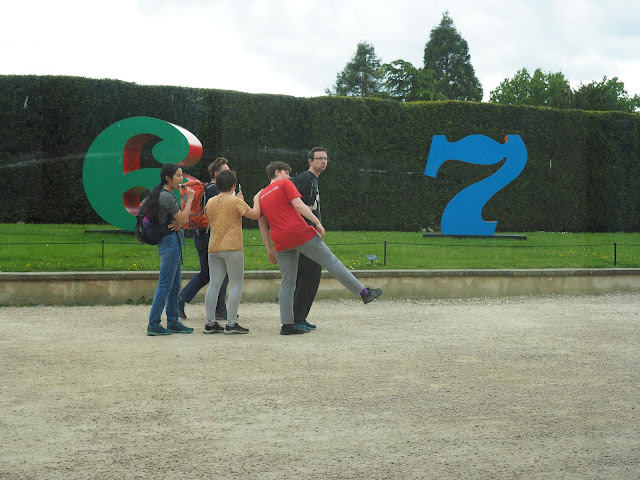 |
| (photo by Michelle Aldrege) |
I’ve said this before so it must surely be true: that walking around
art galleries and museums is a highly specialized, and often very odd, and
sometimes downright absurd, form of pedestrianism. If we accept that art has replaced religion
for a lot of people, then art galleries become sites of non-specific
“spirituality.” Setting foot in the
great Turbine Hall of the Tate Modern in London, or on the spiral slope of the
Guggenheim in New York becomes a kind of secular walking pilgrimage.

This was in my mind even before I went to see the James Turrell
retrospective currently on at the Los Angeles County Museum Of Art, but Turrell’s
works create an even more specialized set of walking-related issues. Much of his work requires the spectator to
walk around a space and an environment, and sometimes that may be a dark, inchoate, Lynchian place; though admittedly some of Turrell’s other work also involves sitting
in one place and zoning out, and one piece in the
current show involves lying flat on your back inside a metal sphere.

I’m pretty sure I first saw his work at the Hayward Gallery in London
in 1993, which would have been an exhibition titled Air Mass. I have very little
recollection of it. I seem to recall
walking around on the flat concrete roof that they call the sculpture court,
though what I was actually looking at has been erased from my memory. I know there was nothing like the thing
below, which featured in a different Hayward exhibition in 2013 titled Light Show.
Then I saw a number of his “skyspaces:” the first at MoMA PS 1 in Queens,
the second in a private home in Brentwood, the third in the Yorkshire Sculpture
Park in Wakefield. In each one, the spectator sits on a bench and looks up at the sky through a hole in the roof.
You see changes in the light and the color of the sky, and more crucially
you start thinking about your own perception of these changes, and about
perception itself. I suppose a person
could walk around in these spaces but nobody ever seems to, and I suspect the other
people in there would be mightily annoyed if you tried it. Ditto if you take in your ghetto blaster.
The place in Yorkshire is called The
Deer
Shelter Skyspace, constructed in a
disused 18th century deer shelter. I suppose I always knew that deer need
shelter, like everybody else, but I had no idea that an 18th landowner
would be inclined to build one for them.
The time I was there, it was a windy winter’s day, the sky was gray and
you looked up through the aperture and saw birds or leaves or twigs flying
across. There was none of that solid,
blue-field, computer screen effect that you get from a California sky, although the pictures on the YSP website show it precisely that way:

A visit to the Yorkshire Sculpture Park actually can involve a
significant amount of walking since it covers
500 acres, with art works scattered throughout.
And when I was there looking at the deer shelter (and I suddenly realize it must have
been as long ago as 2005), there was large Turrell exhibition on there
too. Far and away the most impressive
installation was a piece titled Blue Room,
a pretty much self-explanatory title.
You stood and walked around in a space that looked exactly like this (that's my pal Steve on the far left):
There is something similar in the LA retrospective, titled Ganzfeld (which actually struck me as
slightly over-deterministic title, with its overtones of perceptual
psychology, sensory depravation tanks and what not - Blue Room seems to leave the viewer much freer).

You’re only allowed into the Ganzfeld room as part of a small group, and for
limited amounts of time, but the effect really is wonderful. The room is essentially "featureless," a bit like a cinema,
maybe a bit like a certain kind of minimalist architecture, and there’s nothing
to “see,” so at first it’s completely and utterly disorienting – you feel like
you’re just walking into space, into pure light. But
it’s hard to stand still, you feel compelled to walk around, noticing how the
light changes, and how your perception of the space changes, you notice the
structure of the room, you pace, you avoid the other people, and of course you
can’t help thinking this would be so much better if you were there all by
yourself. Well, I believe Mr. Turrell
is still taking commissions if you ask him nicely. He does after all need the money for his
Roden Crater Project.

Back in the 70s Turrell bought an extinct volcano in Arizona, (don’t you
wish you could put something like that on your CV)? The crater is three miles across and is part
of Turrell’s 150 square miles ranch. He’s
spent the intervening years converting the volcano into a work of art, what is
often described as a “naked eye observatory,” that will eventually have
earthworks, tunnels, and sculptural buildings there too. It sounds as though a lot of walking will be
involved.
Obviously people must go there all the time, journalists, filmmakers,
the guys who do the earth moving, but it’s not open to the public as yet, and since Turrell
is seventy years old, my bet is he’ll die before he “finishes” it. I imagine he wants it that way.
For now, however, you can walk around a large scale model of the thing (that's it above), in a
room at LACMA. I’m a big fan of all
kinds of scale models and dioramas, and if there’s something faintly absurd
about walking respectfully around a highly detailed miniaturized version of a
lump of the Arizona desert, well, it’s the kind of walking absurdity I
absolutely cherish.


















